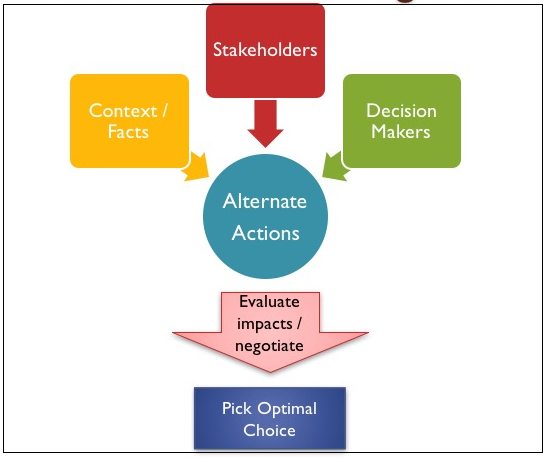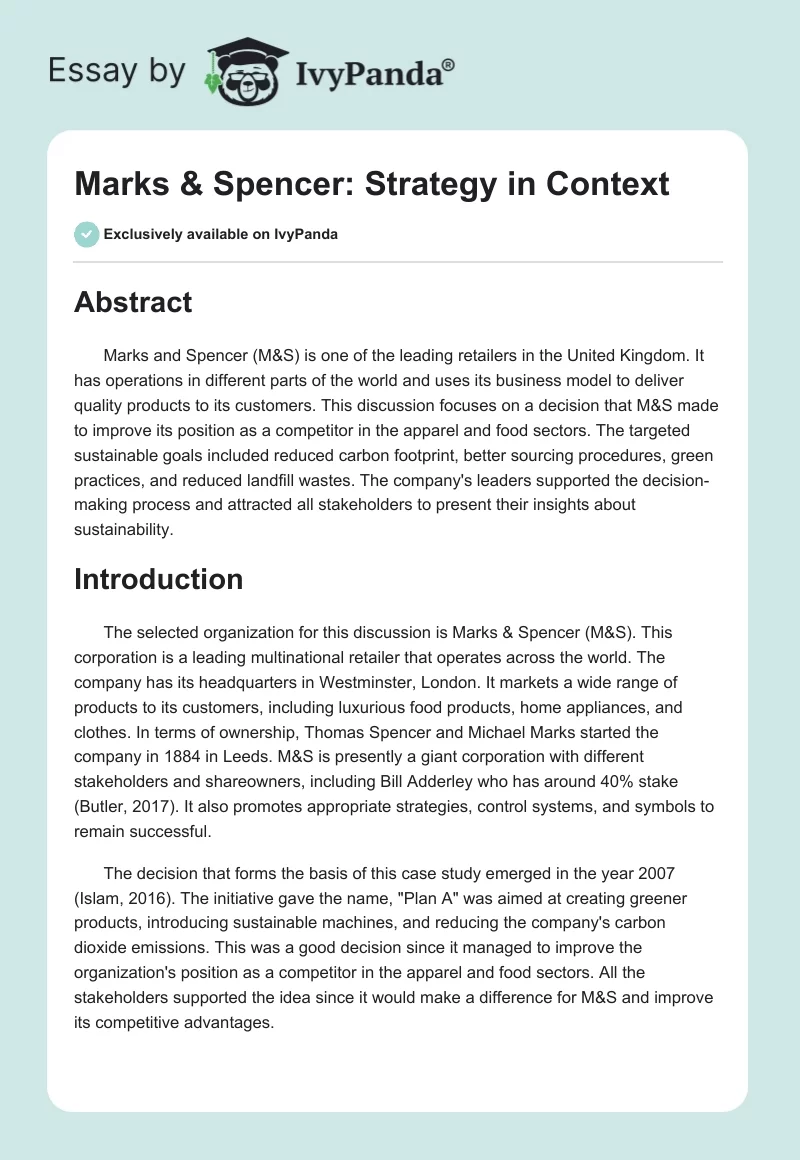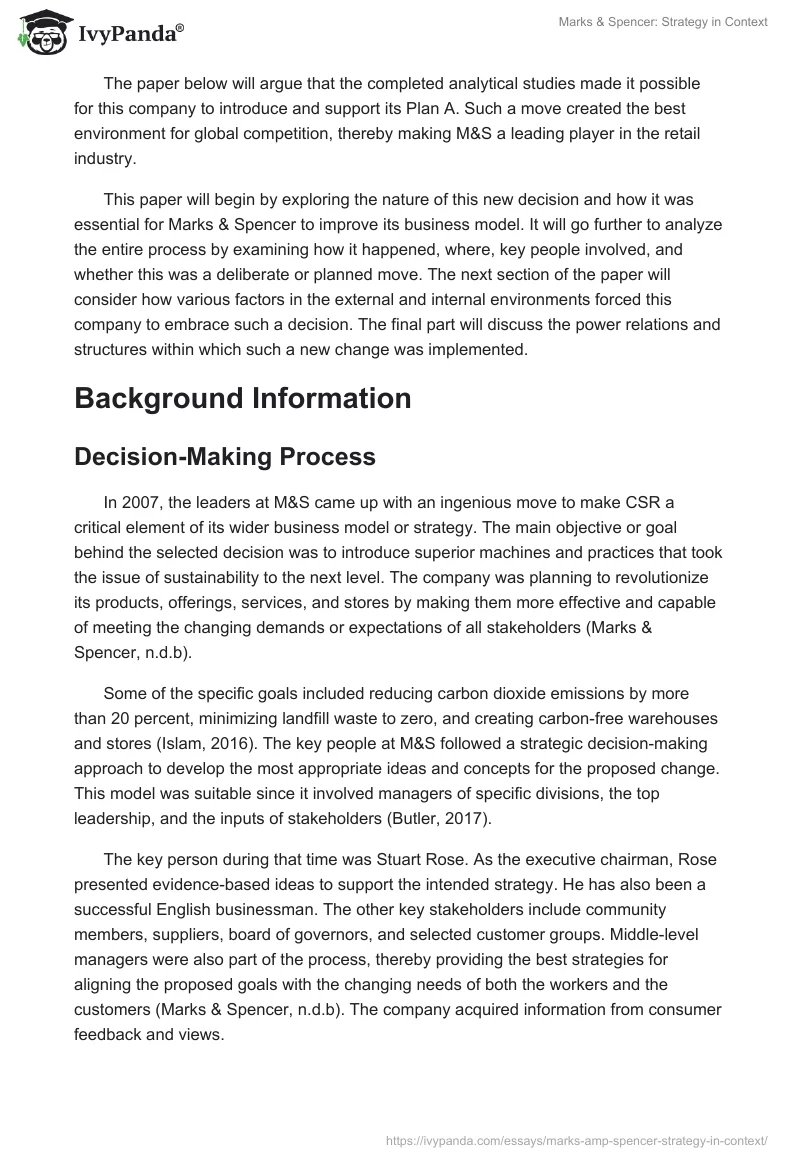Abstract
Marks and Spencer (M&S) is one of the leading retailers in the United Kingdom. It has operations in different parts of the world and uses its business model to deliver quality products to its customers. This discussion focuses on a decision that M&S made to improve its position as a competitor in the apparel and food sectors. The targeted sustainable goals included reduced carbon footprint, better sourcing procedures, green practices, and reduced landfill wastes. The company’s leaders supported the decision-making process and attracted all stakeholders to present their insights about sustainability.
Introduction
The selected organization for this discussion is Marks & Spencer (M&S). This corporation is a leading multinational retailer that operates across the world. The company has its headquarters in Westminster, London. It markets a wide range of products to its customers, including luxurious food products, home appliances, and clothes. In terms of ownership, Thomas Spencer and Michael Marks started the company in 1884 in Leeds. M&S is presently a giant corporation with different stakeholders and shareowners, including Bill Adderley who has around 40% stake (Butler, 2017). It also promotes appropriate strategies, control systems, and symbols to remain successful.
The decision that forms the basis of this case study emerged in the year 2007 (Islam, 2016). The initiative gave the name, “Plan A” was aimed at creating greener products, introducing sustainable machines, and reducing the company’s carbon dioxide emissions. This was a good decision since it managed to improve the organization’s position as a competitor in the apparel and food sectors. All the stakeholders supported the idea since it would make a difference for M&S and improve its competitive advantages.
The paper below will argue that the completed analytical studies made it possible for this company to introduce and support its Plan A. Such a move created the best environment for global competition, thereby making M&S a leading player in the retail industry.
This paper will begin by exploring the nature of this new decision and how it was essential for Marks & Spencer to improve its business model. It will go further to analyze the entire process by examining how it happened, where, key people involved, and whether this was a deliberate or planned move. The next section of the paper will consider how various factors in the external and internal environments forced this company to embrace such a decision. The final part will discuss the power relations and structures within which such a new change was implemented.
Background Information
Decision-Making Process
In 2007, the leaders at M&S came up with an ingenious move to make CSR a critical element of its wider business model or strategy. The main objective or goal behind the selected decision was to introduce superior machines and practices that took the issue of sustainability to the next level. The company was planning to revolutionize its products, offerings, services, and stores by making them more effective and capable of meeting the changing demands or expectations of all stakeholders (Marks & Spencer, n.d.b).
Some of the specific goals included reducing carbon dioxide emissions by more than 20 percent, minimizing landfill waste to zero, and creating carbon-free warehouses and stores (Islam, 2016). The key people at M&S followed a strategic decision-making approach to develop the most appropriate ideas and concepts for the proposed change. This model was suitable since it involved managers of specific divisions, the top leadership, and the inputs of stakeholders (Butler, 2017).
The key person during that time was Stuart Rose. As the executive chairman, Rose presented evidence-based ideas to support the intended strategy. He has also been a successful English businessman. The other key stakeholders include community members, suppliers, board of governors, and selected customer groups. Middle-level managers were also part of the process, thereby providing the best strategies for aligning the proposed goals with the changing needs of both the workers and the customers (Marks & Spencer, n.d.b). The company acquired information from consumer feedback and views.
The involvement of HR leaders in different divisions and regions made it possible for the team to make the most appropriate decision. The managers of different units presented numerous ideas and concepts that would support the change implementation process. As described earlier, the decision-making process took place between 2007 and 2008 (Marks & Spencer, n.d.a). This was also the time when many corporations and companies across Europe were focusing on the most appropriate measures to make their processes, products, and practices more sustainable (León-Bravo, Caniato, Caridi, & Johnsen, 2017). It was also a new opportunity for M&S to transform its business strategy.
The decision-making process took place at this corporate headquarters. The ideas and concepts presented by different stakeholders and people were communicated to other departments and divisions across the world. This move made it possible for all involved parties to consider superior measures for implementing the ideas and taking M&S to the next level (León-Bravo et al., 2017). Another important issue to consider is the nature or originality of this decision.
Sources of Motivation
Different aspects motivate this company and its stakeholders to make various decisions. This organization conceived the described Plan A to record positive results in its key areas, including production and marketing. The fact that many customers expected sustainable products inspired or motivated the company to develop its Plan A agenda. Senay and Landrigan (2018) also acknowledge that many organizations and firms were introducing evidence-based initiatives during that time to maximize performance. This trend made it possible for most of M&S’ stakeholders and leaders to think of a similar strategy.
Another source of motivation was the need to transform this organization’s corporate image. The production and marketing of sustainable products would deliver such a goal and attract more customers. Finally, the predicaments many regions face became powerful guidelines for minimizing carbon dioxide emissions and embracing environmentally-friendly industrial practices. Some of these issues included climate change and global warming.
Driving Forces in the Internal and External Environment
One of the outstanding theories that can support this discussion is the rational model of decision-making. According to Tsolakis, Anastasiadis, and Srai (2018), this framework explains how organizations and human beings develop action plans and ideas that will eventually result in increased outcomes when resources become limited. A computational strategy becomes critical since it guides companies to focus on the emerging issues in their respective industries and mitigate them (Bosch-Badia, Montllor-Serrats, & Tarrazon-Rodon, 2017). The leaders of the company considered this model to promote superior sustainability approaches.
The organizational theory supports the use of various analytical tools to understand the issues that might hinder or promote new changes. A detailed examination of a company’s environment can empower and guide its leaders to make appropriate decisions that can eventually drive organizational performance (Senay & Landrigan, 2018). The best tool that can reveal the major factors that led to this decision is Porter’s 5 Forces.
This framework presents powerful insights and views that can explain why M&S pursued the above decision. The first force outlined in this model is the threat of new entrants (Bennie, 2014). This force is worth considering since newcomers in the supermarket sector will require huge capital and resources. However, M&S’ association and partnership with other companies makes it less vulnerable to entrants. With M&S currently having a strong relationship with different partners, this risk remains low. The second one is that of suppliers’ bargaining power. Existing suppliers in the supermarket sector have a high bargaining power since they produce and distribute a wide range of products (Marks & Spencer, n.d.b). This means that only a small number of suppliers fulfilled the new requirements outlined in Plan A (Marks & Spencer, n.d.a).
The third one is the bargaining power of buyers. With many customers across the world, M&S has to implement powerful initiatives and strategies to meet their needs and achieve its objectives. Some of them include young people, environmentalists, and women. This explains why it considered the importance of a sustainability approach to remain profitable and fulfill the needs of more customers.
The fourth force is the threat of substitutes. This industry has many companies providing apparel products and food materials to many customers in different parts of the world (see Table 1). Its ability to offer products that are produced using green technologies reduces the intensity of this threat (Butler, 2017). The last one is that of industry rivalry. This remains a major force for M&S since many companies are providing superior products using cutting-edge technologies in the region.
Table 1: Porter’s 5 forces (M&S).
The leaders at M&S decided to present evidence-based ideas that would result in a superior CSR strategy. Such a move would ensure that the company was focusing on the bargaining powers of its key customers (Marks & Spencer, n.d.a). Some of the key outcomes anticipated after implementing the recommendations included making M&S a carbon neutral firm, send zero waste to different landfills, empower employees and customers to lead healthier lifestyles, and transform the entire supply chain (Kuehn & McIntire, 2014). The company was also focusing on the decision to support the use of materials obtained or produced using sustainable methods, including water and cotton.
The managers at M&S took the issue of government policy seriously since there was a need for companies to engage in practices that supported the integrity of the natural environment. Such measures were aimed at promoting sustainability, ensuring that corporations presented their reports, and introducing the concept of green accounting (Butler, 2017). With such laws in place, the company’s top management went further to monitor the expectations and needs of different stakeholders and partners (Eweje & Bathurst, 2017). The outstanding observation was that the right time had come for M&S to embrace the idea of sustainability and add value to its key clients.
Power Structures and Relations
From the 1960s, the concept of sustainability became a driving force for many corporations across the globe. Such companies were focusing on evidence-based strategies to produce and deliver healthy products to their customers and protect the natural environment (Oh, Hong, & Hwang, 2017). Towards the end of the 20th century, many countries implemented powerful laws and policies aimed at compelling business organizations to deal with the problems of global warming and climate change (Islam, 2016). Various issues became critical for many companies operating in various sectors, including automobile, textile, apparel, food production, and manufacturing.
The success of the selected decision was, therefore, founded on the existence of appropriate power structures and relations throughout the entire process. Morgan (2015) argues that the leaders at M&S always consider the importance of a corporate governance team that is composed of all key people and players (see Figure 1). Each of these individuals and groups has a role to present ideas that can take the corporation from one point to another (Galant & Cadez, 2017).
The stakeholders involved during the process believed that all decisions or initiatives could succeed if they took the issue of leadership seriously (Agyemang & Ansong, 2016). The individuals shared ideas and focused on the forces experienced in the internal and external environments.
Several situations explain why the corporate governance team made the selected decision successfully. From 2003, all group members and stakeholders began to focus on evidence-based initiatives that would eventually improve this company’s corporate social responsibility (CSR) model (Oh et al., 2017). With this kind of objective, the participants identified the right resources and persons to deliver positive results (Islam, 2016).
Such ideas led to the formulation of M&S’ Plan A. Those in charge of the project were convinced that it would make this organization more sustainable by minimizing its wastes, acquiring raw materials produced using sustainable procedures, and combating climate change (Marks & Spencer, n.d.a). Additionally, the decision would create a better working environment for all employees.
In terms of distance, the stakeholders involved had a significant influence on the nature and future of the decision to introduce sustainability initiatives. The most powerful stakeholder group was that of buyers (Marks & Spencer, n.d.b). As outlined in the above discussion, the bargaining power of customers is always high. This means that M&S considered the demands of these stakeholders in an attempt to remain relevant and achieve its potential.

Different leaders of departments, units, and divisions worked together and interrogated various actions and plans to deliver positive results. They also aligned emerging notions with all aspects of the company’s strategy and performance. All stakeholders remained accountable and responsible in an attempt to offer conceptions that would deliver the most appropriate decision (Marks & Spencer, n.d.b). The managers also pursued the idea of sustainable development to ensure that the decision made the company profitable.
This analysis reveals that there is a strong governance framework at M&S that makes evidence-based decisions and proposes initiatives that can make the company successful. This department encourages all stakeholders to be part of the process, including managers, leaders, customers, and community members (Agyemang & Ansong, 2016). These stakeholders also consider existing insights and policies to record positive results.
This model shows that broad ideological constructs were taken seriously at M&S to deliver this decision. Additionally, external and internal institutional and value systems were involved to support the entire decision-making process. The company introduced the right resources, inputs, and ideas to deliver meaningful results (Lee, Kim, & Lee, 2016). Some of the influential stakeholders involved in the decision-making process included customers, different governments, and organizational leaders.
Conclusion
The above research paper has revealed that different leaders, stakeholders, and partners collaborated to make evidence-based decisions that would eventually make M&S more sustainable. The major factors that contributed to the idea included emerging policies, new trends focusing on sustainability, changing consumer needs, improvement of the company’s CSR strategy, and transformation of the existing business model. The targeted outcomes included reduced carbon footprint, better sourcing procedures, green practices, improved lifestyles for employees and customers, and reduced landfill wastes. The organizational leaders at M&S always consider the unique forces experienced in the external and internal environment to identify emerging concepts that can deliver the most appropriate choice.
References
Agyemang, O. S., & Ansong, A. (2016). Corporate social responsibility and firm performance of Ghanaian SMEs: Mediating role of access to capital and firm reputation. Journal of Global Responsibility, 8(1), 47-62. Web.
Bennie, F. (2014). Circular economy needs consumer demand to gain momentum. The Guardian. Web.
Bosch-Badia, M., Montllor-Serrats, J., & Tarrazon-Rodon, M. (2017). Efficiency and sustainability of CSR projects. Sustainability, 9(10), 1714-1731. Web.
Butler, S. (2017). M&S offers cash grants to community businesses in ethical relaunch. The Guardian. Web.
Eweje, G., & Bathurst, R. (Eds.). (2017). CSR, sustainability, and leadership. New York, NY: Taylor & Francis.
Galant, A., & Cadez, S. (2017). Corporate social responsibility and financial performance relationship: A review of measurement approaches. Economic Research-Ekonomska Istraživanja, 30(1), 676-693. Web.
Islam, K. (2016). Can ethical business strategy influence consumers’ buying behaviour and loyalty: Marks and Spencer PLC? Case Studies in Business and Management, 3(1), 38-63. Web.
Kuehn, K., & McIntire, L. (2014). Sustainability a CFO can love. Harvard Business Review. Web.
Lee, J. S., Kim, S. K., & Lee, S. (2016). Sustainable supply chain capabilities: Accumulation, strategic types and performance. Sustainability, 8(6), 500-515. Web.
León-Bravo, V., Caniato, F., Caridi, M., & Johnsen, T. (2017). Collaboration for sustainability in the food supply chain: A multi-stage study in Italy. Sustainability, 9(7), 1253-1273. Web.
Marks & Spencer (n.d.a). Make it matter. Web.
Marks & Spencer. (n.d.b). Sustainability. Web.
Morgan, E. (2015). ‘Plan A’: Analysing business model innovation for sustainable consumption in mass-market clothes retailing. Journal of Corporate Citizenship, 57, 73-98. Web.
Oh, S., Hong, A., & Hwang, J. (2017). An analysis of CSR on firm financial performance in stakeholder perspectives. Sustainability, 9(6), 1023-1034. Web.
Senay, E., & Landrigan, P. J. (2018). Assessment of environmental sustainability and corporate social responsibility reporting by large health care organisations. JAMA Network Open, 1(4), e180975. Web.
Tsolakis, N., Anastasiadis, F., & Srai, J. S. (2018). Sustainability performance in food supply networks: Insights from the UK industry. Sustainability, 10(9), 3148-3160. Web.


